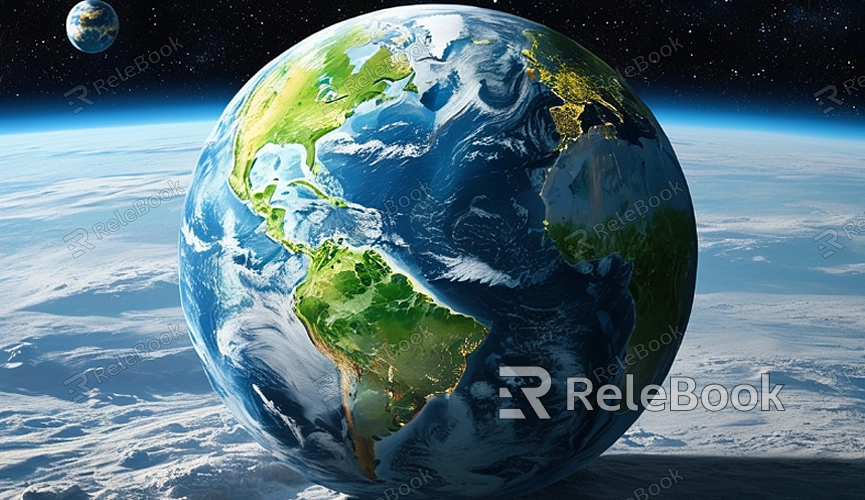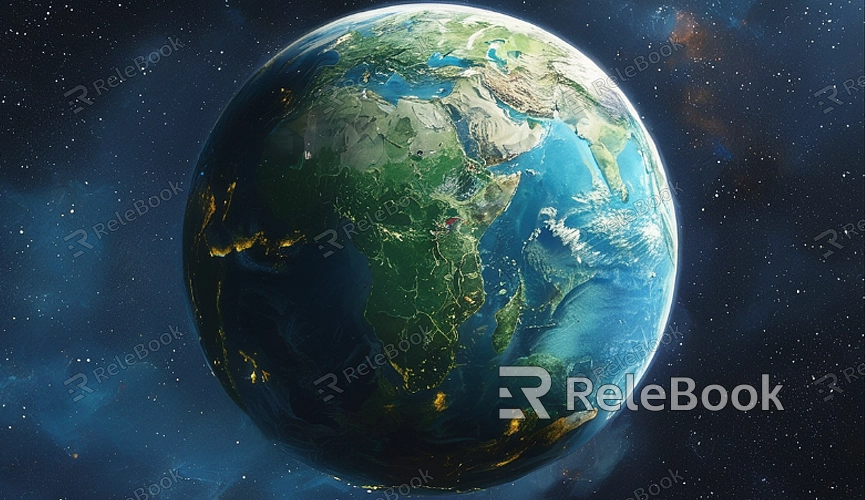How to Create a 3D Earth Model?
By crafting an Earth model, you can showcase geographical features like continents, ocean distributions, and the Earth's rotation. Whether used as an educational tool or for personal projects, this endeavor holds significant value. This article will detail the process of creating a complete 3D Earth model, from selecting the right tools to applying textures, guiding you step-by-step.In the following sections, you will learn about the necessary tools for creating a 3D Earth model, the basic steps involved, and some practical tips.

Choose the Right Modeling Software
Before making a 3D Earth model, it’s essential to select suitable 3D modeling software. Different programs have various features and levels of complexity, so you can choose based on your needs and skill level. Common modeling tools include:
1. Blender: Free and open-source, suitable for everyone from beginners to advanced users with powerful features.
2. Maya: An industry-standard 3D software widely used in film and animation, ideal for professionals.
3. 3ds Max: Another powerful 3D modeling tool commonly used in gaming and architecture.
4. Cinema 4D: Known for its intuitive interface and strong capabilities, especially for visual effects.
For beginners, Blender is recommended due to its free availability and extensive user community with numerous tutorial resources.
Create the Basic Geometry of the Earth
The core of the Earth model is a simple sphere, as the Earth's shape closely resembles an oblate spheroid. Here are the steps to create this basic geometry:
1. Create a Sphere in the Software: Most 3D modeling software includes a pre-set sphere as a basic geometric shape. You can directly select the sphere from the tool library and adjust its size to approximate the real Earth's proportions.
2. Refine the Details: While the initial sphere model appears simple, you can increase the number of faces or subdivide the mesh to enhance its accuracy, ensuring a smooth surface for displaying Earth's features. Additionally, you can opt for an oblate sphere to better simulate the Earth's actual shape.
By completing this step, you will have a basic Earth model that lays the foundation for the subsequent texture and detail applications.

Add Surface Textures to the Earth
A realistic 3D Earth model relies heavily on high-quality textures. Textures can showcase the Earth’s landmasses, oceans, and mountains, making it visually appealing. To achieve this, you need to find high-resolution Earth texture images and apply them to the sphere.
1. Obtain Earth Texture Maps: You can download free Earth surface images from NASA or other scientific websites. These images typically include oceans, continents, mountains, and snow-covered areas.
2. Apply Textures: In software like Blender, you can use the "UV mapping" feature to properly map the Earth's surface texture onto the sphere. UV mapping is a method of unfolding a 2D image and fitting it onto a 3D object’s surface. By adjusting UV mapping parameters, you can ensure the texture covers the Earth's surface accurately.
3. Handle the Details: In addition to the basic surface texture, you can add extra layers, such as ocean reflections or atmospheric transparency. These details will make your Earth model appear more realistic.
Create Atmospheric and Cloud Effects
To enhance your 3D Earth model, adding an atmosphere and cloud layers is essential. The Earth’s atmosphere and clouds provide dynamic visual effects, making it look more natural.
1. Create the Atmosphere: You can simulate the atmosphere by creating a slightly larger transparent sphere surrounding the Earth. Use a transparent material to render this sphere, creating a hazy effect similar to the atmosphere. Adjust transparency and light refraction to capture the essence of the Earth’s atmosphere.
2. Add Cloud Layers: Obtain high-resolution cloud images and apply them in a similar manner to the Earth's surface textures. Create a separate sphere for the clouds, slightly larger than the Earth’s surface sphere, so that the clouds appear to hover above it.
3. Adjust Dynamic Effects: If you want the model to be more interactive, consider setting a rotation animation for the cloud layers, allowing them to change slowly as the Earth rotates. This addition gives your Earth model more vitality.
Implement Lighting and Rendering
Lighting is a key factor in bringing your 3D Earth model to life. Through proper light source setup, you can illustrate the day-night cycle and the scattering and reflection of the atmosphere.
1. Set Up Main Light Source: To simulate sunlight, you can place a strong directional light to illuminate one side of the Earth model. This setup allows one half of the Earth to be lit while the other remains in shadow, realistically showcasing the day-night transition.
2. Add Ambient Light: Include soft ambient light to balance the intensity of the light, preventing the model from appearing completely black in shadowed areas. This approach helps present a natural light-shadow effect on the Earth.
3. Render the Model: After completing the lighting setup, you can proceed to the final rendering. Rendering generates the final image or animation. By adjusting rendering settings, you can ensure the output has high-quality details and lighting effects.
Add Earth Rotation Animation
In addition to a static Earth model, you can create animation effects like the Earth’s rotation. Rotation animation not only makes the model more interactive but also adds visual interest.
1. Set the Rotation Axis: The Earth rotates around a tilted axis, usually about 23.5 degrees. In 3D modeling software, you can align the model’s rotation axis with the Earth’s axis.
2. Adjust Animation Speed: Depending on the rotation speed of the Earth, you can set a slow rotation animation for the model. Typically, the rotation speed should be slow enough for viewers to appreciate the changing surface details.
3. Render the Animation: Once the animation settings are complete, you can render the animation. Rendering will generate a series of sequential image frames that create a smooth rotation effect video.
Refine Details and Optimize the Model
The final step is to review the model’s overall effect and make optimizations. At this stage, you can adjust the model’s details, texture quality, lighting effects, and animation smoothness as needed.
1. Optimize Polygon Count: Ensure the model’s polygon count is high enough to maintain detail but not excessively high to avoid impacting rendering speed. By reducing unnecessary polygons, you can enhance the model's performance.
2. Test Different Perspectives: View the model from various angles to check if the textures and lighting appear uniform. Pay special attention to the poles and equatorial regions to ensure textures do not stretch or distort.
3. Check Rendering Time: If your model will be used for real-time applications (such as games or interactive displays), ensure its rendering time is short enough to provide a smooth user experience.
Creating a 3D Earth model requires some technical skill and patience, but by choosing the right software, applying high-quality textures, setting up lighting and animations, you can craft a realistic and interactive Earth model. Whether used for educational, display, or personal projects, such a 3D model offers significant visual impact. If you wish to enrich your work further, you can download 3D models and textures from the Relebook website, gaining access to high-quality resources to enhance your creative experience.
FAQ
How can I find high-quality texture maps for the Earth model?
You can download free Earth texture images from sites like NASA, which often provide high-resolution maps covering the surface, clouds, and nighttime lights.
How can I make my Earth model look more realistic?
In addition to using high-resolution textures, you can add atmospheric layers, cloud coverage, and lighting effects, and set up rotation animations to enhance realism.
Can I create an Earth model using other 3D software?
Absolutely! While this article primarily discusses Blender, you can use Maya, 3ds Max, or other 3D software to create an Earth model; the specific steps may vary.
How can I reduce the rendering time of the model?
You can effectively reduce rendering time by lowering the polygon count, optimizing texture sizes, and adjusting rendering settings.

